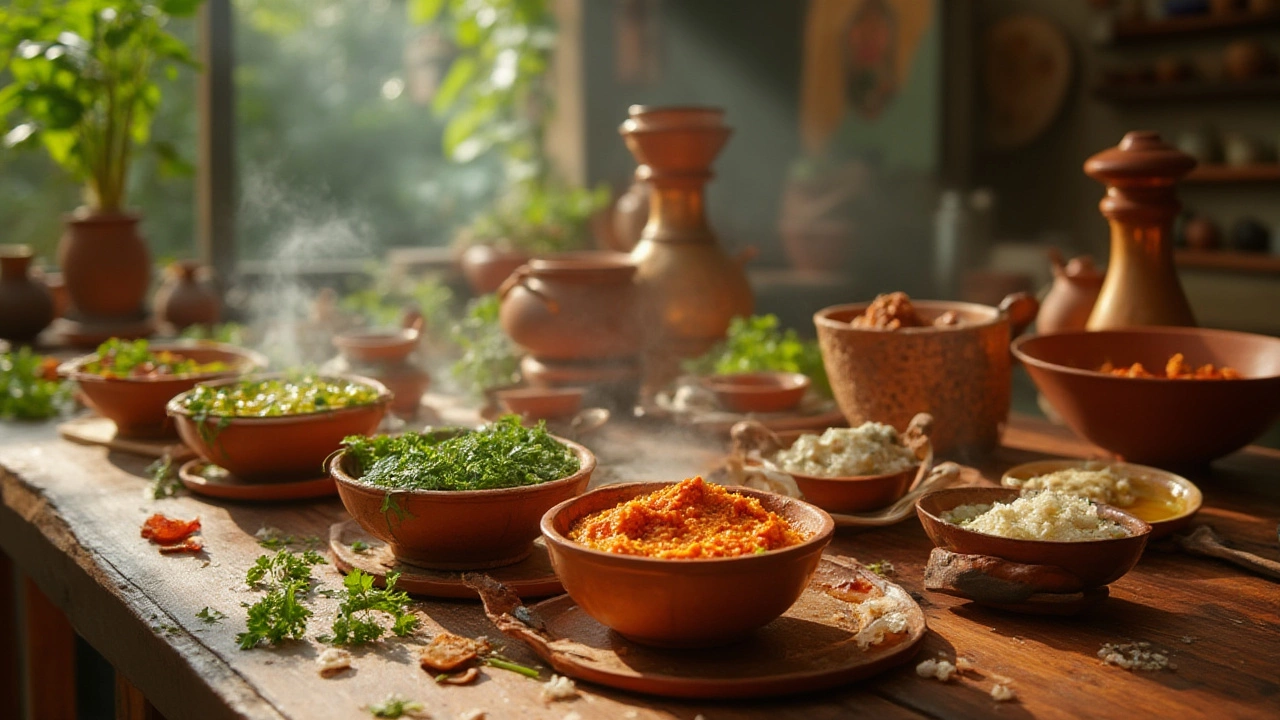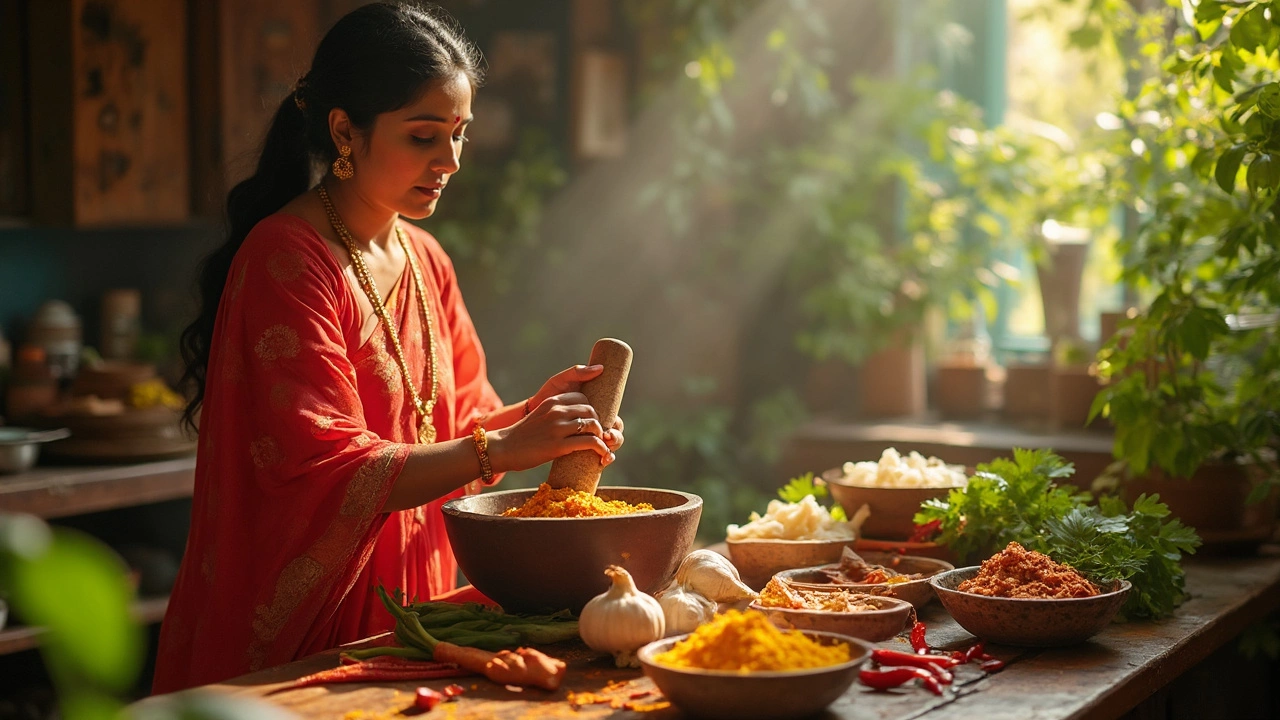Chutney – The Indian Condiment Everyone Loves
When talking about Chutney, a blend of fruits, vegetables, herbs, spices, and sometimes nuts that’s cooked or raw to create a flavorful side. Also known as Indian relish, it adds heat, sweetness, or tang to a meal and works across breakfast, lunch, and dinner. Relish, a milder, often vinegar‑based accompaniment popular in Western cuisines shares the idea of mixing ingredients, but chutney usually leans on spice blends and fresh herbs. Condiment, any sauce or paste that enhances the main dish is the broader category that includes both chutney and relish. In short, chutney is an Indian condiment that blends fruit, spice, and herb to boost flavor.
Chutney isn’t a single recipe; it’s a family of spice blend variations that reflect regional tastes. South Indian coconut chutney relies on ground coconut, green chilies, and curry leaves, while Punjabi mint chutney mixes fresh mint, cilantro, and a splash of lemon. The choice of fruit—mango, tamarind, tomato—determines whether the result is sweet, sour, or a mix of both. Herbs like cilantro and mint bring brightness, and spices such as cumin, mustard seeds, and garam masala give depth. Because each element contributes a specific attribute, the whole chutney is more than the sum of its parts.
How Chutney Connects to Everyday Kitchen Questions
Many home cooks wonder how chutney differs from relish. The key difference lies in preparation and flavor emphasis: chutney often cooks the base ingredients, allowing the spices to meld, while relish stays crunchy and relies on acidity for preservation. This distinction matters when you store the sauce. Homemade chutney can last a week in the fridge, up to three months in the pantry if it’s high in sugar or vinegar, and even longer when canned properly. Knowing the right storage method prevents spoilage and keeps the taste sharp.
Another common query is the shelf life of chutney. The acidity from lemon or tamarind, plus sugar, acts as a natural preservative. In the fridge, a fresh coconut chutney will stay good for 5‑7 days; a fruit‑based mango chutney can stretch to 2‑3 weeks. When you canner it, the sealed jars maintain safety for up to a year. Spotting spoilage signs—off‑smell, mold, bubbling—helps you avoid food waste. The process of making chutney also ties into Indian cuisine fundamentals. A typical curry uses a base of onion, tomato, and spices; adding a spoonful of chutney at the end can brighten the sauce, balance heat, or add a fruity note. Likewise, a simple roti or dosa experience improves dramatically with a dab of chutney on the side.
Because chutney is versatile, it works for vegetarians and meat‑eaters alike. A vegetarian menu can feature a trio of mango, cilantro, and peanut chutneys to accompany dal, paneer, or vegetable biryani. For meat lovers, a spicy tomato chutney pairs well with tandoori chicken or kebabs, cutting through richness. The flexibility comes from the fact that chutney is essentially a condiment, so you can adjust heat, sweetness, or tang to match any main dish.
From a nutritional view, chutney can add vitamins, antioxidants, and fiber. Fresh herbs contribute vitamin C and K, while fruits bring natural sugars and micronutrients. Using minimal oil keeps the calorie count low, making chutney a healthy way to boost flavor without extra fat. If you’re watching salt, you can rely on spices and citrus to bring the punch instead of adding extra sodium.
Finally, chutney ties into broader food trends like DIY condiments and sustainable cooking. Making chutney at home lets you use leftover vegetables—like carrot or beet tops—reducing waste. It also allows you to control sugar and spice levels, catering to personal health goals. Whether you’re prepping a weekly meal plan or experimenting with fusion dishes, a batch of homemade chutney can be the secret weapon that saves time and adds excitement.
Below, you’ll find a curated collection of articles that dive deeper into chutney topics—from classic recipes and regional guides to storage hacks and the chutney‑versus‑relish debate. Explore the posts to sharpen your skills, discover new flavor combos, and learn practical tips you can apply right away in your kitchen.

Should Chutney Be Served Hot or Cold? Indian Cuisine Secrets Revealed
Should you eat chutney hot or cold? Find out how temperature changes flavor and texture, plus tips for getting the most from every spoonful.

Is Pickle a Chutney? Clearing Up the Confusion
People often mix up pickles and chutneys, but they're not the same thing. This article breaks down what sets them apart and explores where the confusion comes from. You'll get clear tips on how to tell the difference at home, plus quick facts that might surprise you. Perfect if you love Indian food or are just curious about condiments. Get ready for some useful kitchen insights.

Is Chutney Anti-Inflammatory? The Surprising Truth Behind This Popular Condiment
Chutney often gets tossed on the plate as just an extra, but this zingy condiment can be packed with ingredients that fight inflammation. This article breaks down what goes into typical chutney recipes and why those herbs, spices, and fruits matter for your health. We’ll dig into what research says about classic chutney ingredients like ginger, turmeric, and garlic. Plus, there are easy tips on making your own anti-inflammatory chutney at home. Find out which combinations bring the most benefits when you whip up your next batch.